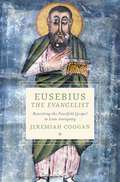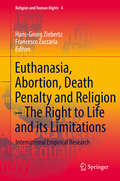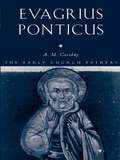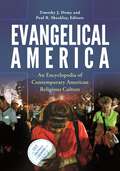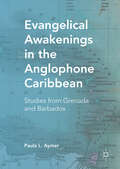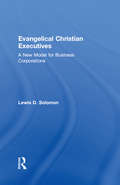- Table View
- List View
Europe's Inner Demons: The Demonization of Christians in Medieval Christendom
by Norman CohnEurope's Inner Demons is a fascinating history of the irrational need to imagine witches and an investigation of how those fantasies made the persecutions of the middle ages possible. In addition, Norman Cohn's discovery that some influential sources on European witch trials were forgeries has revolutionized the field of witchcraft, making this one of the most essential books ever written on the subject.
The Eusebian Canon Tables: Ordering Textual Knowledge in Late Antiquity (Oxford Early Christian Studies)
by Matthew R. CrawfordOne of the books most central to late-antique religious life was the four-gospel codex, containing the Gospels of Matthew, Mark, Luke, and John. A common feature in such manuscripts was a marginal cross-referencing system known as the Canon Tables. This reading aid was invented in the early fourth century by Eusebius of Caesarea and represented a milestone achievement both in the history of the book and in the scholarly study of the fourfold gospel. In this work, Matthew R. Crawford provides the first book-length treatment of the origins and use of the Canon Tables apparatus in any language. Part one begins by defining the Canon Tables as a paratextual device that orders the textual content of the fourfold gospel. It then considers the relation of the system to the prior work of Ammonius of Alexandria and the hermeneutical implications of reading a four-gospel codex equipped with the marginal apparatus. Part two transitions to the reception of the paratext in subsequent centuries by highlighting four case studies from different cultural and theological traditions, from Augustine of Hippo, who used the Canon Tables to develop the first ever theory of gospel composition, to a Syriac translator in the fifth century, to later monastic scholars in Ireland between the seventh and ninth centuries. Finally, from the eighth century onwards, Armenian commentators used the artistic adornment of the Canon Tables as a basis for contemplative meditation. These four case studies represent four different modes of using the Canon Tables as a paratext and illustrate the potential inherent in the Eusebian apparatus for engaging with the fourfold gospel in a variety of ways, from the philological to the theological to the visual.
The Eusebian Canon Tables: Ordering Textual Knowledge in Late Antiquity (Oxford Early Christian Studies)
by Matthew R. CrawfordOne of the books most central to late-antique religious life was the four-gospel codex, containing the Gospels of Matthew, Mark, Luke, and John. A common feature in such manuscripts was a marginal cross-referencing system known as the Canon Tables. This reading aid was invented in the early fourth century by Eusebius of Caesarea and represented a milestone achievement both in the history of the book and in the scholarly study of the fourfold gospel. In this work, Matthew R. Crawford provides the first book-length treatment of the origins and use of the Canon Tables apparatus in any language. Part one begins by defining the Canon Tables as a paratextual device that orders the textual content of the fourfold gospel. It then considers the relation of the system to the prior work of Ammonius of Alexandria and the hermeneutical implications of reading a four-gospel codex equipped with the marginal apparatus. Part two transitions to the reception of the paratext in subsequent centuries by highlighting four case studies from different cultural and theological traditions, from Augustine of Hippo, who used the Canon Tables to develop the first ever theory of gospel composition, to a Syriac translator in the fifth century, to later monastic scholars in Ireland between the seventh and ninth centuries. Finally, from the eighth century onwards, Armenian commentators used the artistic adornment of the Canon Tables as a basis for contemplative meditation. These four case studies represent four different modes of using the Canon Tables as a paratext and illustrate the potential inherent in the Eusebian apparatus for engaging with the fourfold gospel in a variety of ways, from the philological to the theological to the visual.
Eusebius (Understanding Classics)
by Aaron P. JohnsonEusebius of Caesarea (263-339 CE) is one of the most important intellectuals whose writings survive from late antiquity. His texts made lasting and wide-ranging contributions, from history-writing and apologetics to biblical commentary and Christian oratory. He was a master of many of the literary and scholarly traditions of the Greek heritage. Yet he left none of these traditions unaltered as he made brilliant and original experiments in the many genres he explored. Aaron P Johnson offers a lively introduction to Eusebius' chief oeuvre while also discussing recent scholarship on this foundational early Christian writer. Placing Eusebius in the context of his age the author provides a full account his life, including the period when Eusebius controversially sought to assist the heretic Arius. He then discusses the major writings: apologetic treatises; the pedagogical and exegetical works; the historical texts; the anti-Marcellan theological discourses; and expositions directly connected to the Emperor Constantine.
Eusebius the Evangelist: Rewriting the Fourfold Gospel in Late Antiquity (Cultures of Reading in the Ancient Mediterranean)
by Jeremiah CooganEusebius the Evangelist analyzes Eusebius of Caesarea's fourth-century reconfiguration of the Gospels as a window into broader questions of technology and textuality in the ancient Mediterranean. The four Gospels of the New Testament (Matthew, Mark, Luke, and John) share language, narratives, and ideas, yet they also differ in structure and detail. The sophisticated system through which Eusebius organized this intricate web of textual relationships is known as the Eusebian apparatus. Eusebius' editorial interventioninvolving tables, sectioning, and tables of contentsparticipates in a broader late ancient transformation in reading and knowledge. To illuminate Eusebius' innovative use of textual technologies, the study juxtaposes diverse ancient disciplinesincluding chronography, astronomy, geography, medicine, philosophy, and textual criticismwith a wide range of early Christian sources, attending to neglected evidence from material texts and technical literature. These varied phenomena reveal how Eusebius' fourfold Gospel worked in the hands of readers. Eusebius' creative juxtapositions of Gospel material had an enduring impact on Gospel reading. Not only did Eusebius continue earlier trajectories of Gospel writing, but his apparatus continued to generate new possibilities in the hands of readers. For more than a millennium, in over a dozen languages and in thousands of manuscripts, Eusebius' invention transformed readers' encounters with Gospel text on the page. By employing emerging textual technologies, Eusebius created new possibilities of reading, thereby rewriting the fourfold Gospel in a significant and durable way.
Eusebius the Evangelist: Rewriting the Fourfold Gospel in Late Antiquity (Cultures of Reading in the Ancient Mediterranean)
by Jeremiah CooganEusebius the Evangelist analyzes Eusebius of Caesarea's fourth-century reconfiguration of the Gospels as a window into broader questions of technology and textuality in the ancient Mediterranean. The four Gospels of the New Testament (Matthew, Mark, Luke, and John) share language, narratives, and ideas, yet they also differ in structure and detail. The sophisticated system through which Eusebius organized this intricate web of textual relationships is known as the Eusebian apparatus. Eusebius' editorial interventioninvolving tables, sectioning, and tables of contentsparticipates in a broader late ancient transformation in reading and knowledge. To illuminate Eusebius' innovative use of textual technologies, the study juxtaposes diverse ancient disciplinesincluding chronography, astronomy, geography, medicine, philosophy, and textual criticismwith a wide range of early Christian sources, attending to neglected evidence from material texts and technical literature. These varied phenomena reveal how Eusebius' fourfold Gospel worked in the hands of readers. Eusebius' creative juxtapositions of Gospel material had an enduring impact on Gospel reading. Not only did Eusebius continue earlier trajectories of Gospel writing, but his apparatus continued to generate new possibilities in the hands of readers. For more than a millennium, in over a dozen languages and in thousands of manuscripts, Eusebius' invention transformed readers' encounters with Gospel text on the page. By employing emerging textual technologies, Eusebius created new possibilities of reading, thereby rewriting the fourfold Gospel in a significant and durable way.
Euthanasia, Abortion, Death Penalty and Religion - The Right to Life and its Limitations: International Empirical Research (Religion and Human Rights #4)
by Hans-Georg Ziebertz Francesco ZaccariaThis book considers how the termination of life might be accepted in the view of a general obligation to protect life. It features more than 10 papers written by scholars from 14 countries that offer international comparative empirical research. Inside, readers will find case studies from such areas as: India, Chile, Germany, Italy, England, Palestine, Lithuania, Nigeria, and Poland. The papers focus on three limitations of the right to life: the death penalty, abortion, and euthanasia. The contributors explore how young people understand and evaluate the right to life and its limitations. The book presents unique empirical research among today's youth and reveals that, among other concepts, religiosity matters. It provides insight into the acceptance, perception, and legitimation of human rights by people from different religious and cultural backgrounds. This investigation rigorously tests for inter-individual differences regarding political and judicial rights on religious grounds, while controlling for other characteristics. It will help readers better understand the many facets of this fundamental, yet controversial, philosophical question. The volume will be of interest to students, researchers, as well as general readers searching for answers.
Euthanasia of a Mission: African Church Autonomy in a Colonial Context (Non-ser.)
by Jehu HancilesHenry Venn, secretary of the London-based Church Missionary Society from 1840 to 1872, coined the term euthanasia of a mission to describe the vital process whereby a foreign mission becomes progressively indigenous and independent. His vision of church autonomy was first implemented in Sierra Leone, and the author examines this experiment in detail to uncover the nature of early efforts at constructing an African Christian identity separate from foreign influence and control. Through a detailed analysis of the crises and controversies evoked by African interpretation and appropriation of Venn's vision, the author illustrates the complex interaction of foreign missionary action, indigenous Christian response, and socioeconomic factors in the problematic transition from mission to national church.Venn's ideas had far-reaching influence on the growth of African nationalism, political consciousness, and nation-building. His experiment led to local efforts to merge with the foreign missionary efforts and to an eventual takeover of leadership and mission responsibilities by native Africans. Hanciles chronicles the initial missionary efforts in Sierra Leone, the growth of the mission, the problems that arose, and the emergence of Ethiopianism, a movement which promoted the idea of African nationalism. The book argues that in the West African region, at least, Venn's experiment precipitated some of the most profound ecclesiastical crises of the 19th century and unleashed powerful forces of change that continue to this day. By focusing on the African factor in the intensely problematic transition from mission to national church, this work contributes to the ongoing reappraisal of the significance of African Christianity as a major stream of Christian history.
Evagrius and Gregory: Mind, Soul and Body in the 4th Century (Studies in Philosophy and Theology in Late Antiquity)
by Kevin CorriganEvagrius of Pontus and Gregory of Nyssa have either been overlooked by philosophers and theologians in modern times, or overshadowed by their prominent friend and brother (respectively), Gregory Nazianzus and Basil the Great. Yet they are major figures in the development of Christian thought in late antiquity and their works express a unique combination of desert and urban spiritualities in the lived and somewhat turbulent experience of an entire age. They also provide a significant link between the great ancient thinkers of the past - Plato, Aristotle, the Stoics, Clement and others - and the birth and transmission of the early Medieval period - associated with Boethius, Cassian and Augustine. This book makes accessible, to a wide audience, the thought of Evagrius and Gregory on the mind, soul and body, in the context of ancient philosophy/theology and the Cappadocians generally. Corrigan argues that in these two figures we witness the birth of new forms of thought and science. Evagrius and Gregory are no mere receivers of a monolithic pagan and Christian tradition, but innovative, critical interpreters of the range and limits of cognitive psychology, the soul-body relation, reflexive self-knowledge, personal and human identity and the soul’s practical relation to goodness in the context of human experience and divine self-disclosure. This book provides a critical evaluation of their thought on these major issues and argues that in Evagrius and Gregory we see the important integration of many different concerns that later Christian thought was not always able to balance including: mysticism, asceticism, cognitive science, philosophy, and theology.
Evagrius and Gregory: Mind, Soul and Body in the 4th Century (Studies in Philosophy and Theology in Late Antiquity)
by Kevin CorriganEvagrius of Pontus and Gregory of Nyssa have either been overlooked by philosophers and theologians in modern times, or overshadowed by their prominent friend and brother (respectively), Gregory Nazianzus and Basil the Great. Yet they are major figures in the development of Christian thought in late antiquity and their works express a unique combination of desert and urban spiritualities in the lived and somewhat turbulent experience of an entire age. They also provide a significant link between the great ancient thinkers of the past - Plato, Aristotle, the Stoics, Clement and others - and the birth and transmission of the early Medieval period - associated with Boethius, Cassian and Augustine. This book makes accessible, to a wide audience, the thought of Evagrius and Gregory on the mind, soul and body, in the context of ancient philosophy/theology and the Cappadocians generally. Corrigan argues that in these two figures we witness the birth of new forms of thought and science. Evagrius and Gregory are no mere receivers of a monolithic pagan and Christian tradition, but innovative, critical interpreters of the range and limits of cognitive psychology, the soul-body relation, reflexive self-knowledge, personal and human identity and the soul’s practical relation to goodness in the context of human experience and divine self-disclosure. This book provides a critical evaluation of their thought on these major issues and argues that in Evagrius and Gregory we see the important integration of many different concerns that later Christian thought was not always able to balance including: mysticism, asceticism, cognitive science, philosophy, and theology.
Evagrius of Pontus: The Gnostic Trilogy
by Robin Darling Young Joel Kalvesmaki Columba Stewart Charles M. Stang Fr. Luke DysingerThe Gnostic Trilogy is the best-known and most important work by the ascetic philosopher and teacher Evagrius of Pontus. Among the writers of his age, Evagrius stands out for his short, perplexing, and absorbing aphorisms, which provide sharp insight into philosophy, Scripture, human nature, and the natural world. The first part of the trilogy, the Praktikos (The Practiced One), provides a diagnosis and treatment of the eight tempting thoughts. It was a foundational text for monastic asceticism and was the basis for the later Seven Deadly sins tradition. The second, Gnostikos (The Knower), explains how someone who has mastered the body and mental delusions should teach others. The third, longest, and most controversial, the Kephalaia gnostika (Gnostic Chapters), ranges broadly over the origin of the universe, the nature of rational beings, and the hidden symbols of Scripture. This part was responsible for Evagrius's condemnation as a heretic and, as a result, does not survive intact in the original Greek and must be restored from ancient translations. This volume presents the Trilogy in its entirety for the first time since antiquity and provides a fresh, comprehensive English translation of all three works, in all their known ancient versions, both Greek and Syriac. Detailed explanatory notes, cross-references to Scripture, to ancient literature, and to Evagrius's other writings, as well as commentary on the translation techniques of the Syriac translators, provide the necessary resources for understanding this significant but puzzling text.
Evagrius of Pontus: The Gnostic Trilogy
by Robin Darling Young Joel Kalvesmaki Columba Stewart Charles M. Stang Fr. Luke DysingerThe Gnostic Trilogy is the best-known and most important work by the ascetic philosopher and teacher Evagrius of Pontus. Among the writers of his age, Evagrius stands out for his short, perplexing, and absorbing aphorisms, which provide sharp insight into philosophy, Scripture, human nature, and the natural world. The first part of the trilogy, the Praktikos (The Practiced One), provides a diagnosis and treatment of the eight tempting thoughts. It was a foundational text for monastic asceticism and was the basis for the later Seven Deadly sins tradition. The second, Gnostikos (The Knower), explains how someone who has mastered the body and mental delusions should teach others. The third, longest, and most controversial, the Kephalaia gnostika (Gnostic Chapters), ranges broadly over the origin of the universe, the nature of rational beings, and the hidden symbols of Scripture. This part was responsible for Evagrius's condemnation as a heretic and, as a result, does not survive intact in the original Greek and must be restored from ancient translations. This volume presents the Trilogy in its entirety for the first time since antiquity and provides a fresh, comprehensive English translation of all three works, in all their known ancient versions, both Greek and Syriac. Detailed explanatory notes, cross-references to Scripture, to ancient literature, and to Evagrius's other writings, as well as commentary on the translation techniques of the Syriac translators, provide the necessary resources for understanding this significant but puzzling text.
Evagrius Ponticus (The Early Church Fathers)
by Augustine CasidayPresenting many texts available for the very first time, this new volume in the successful Early Church Fathers series showcases full translations of Evagrius' letters, notes on various books of the bible, his treatises and his 'chapters'. Augustine Casiday's material is both accurate and refreshingly approachable, and the work is prefaced by a solid introductory essay that presents Evagrius, his work and influences, and modern scholarship in an easy-to-understand way for beginners. For students dealing with Evagrius for the first time, they could not find a better book to begin their exploration of this figure in late-ancient history and theology.
Evagrius Ponticus (The Early Church Fathers)
by Augustine CasidayPresenting many texts available for the very first time, this new volume in the successful Early Church Fathers series showcases full translations of Evagrius' letters, notes on various books of the bible, his treatises and his 'chapters'. Augustine Casiday's material is both accurate and refreshingly approachable, and the work is prefaced by a solid introductory essay that presents Evagrius, his work and influences, and modern scholarship in an easy-to-understand way for beginners. For students dealing with Evagrius for the first time, they could not find a better book to begin their exploration of this figure in late-ancient history and theology.
Evaluating Employee Performance through Christian Virtues
by Mihai C. Bocarnea Joshua Henson Russell L. Huizing Michael Mahan Bruce E. WinstonIn this book the authors create a statistically validated scale measuring the display of each of the nine fruit of the spirit in employees. The authors will discuss how biblical values are applicable to contemporary organizational leadership and management. These nine virtues span a wide breadth of important personal and organizational attributes including benevolence, affection, gladness, relational harmony, tranquility, perseverance, helpfulness, caring for the welfare of others, adherence to the beliefs and value of others, power used soberly, and mastering one’s desires. While diverse in nature, the list also suggests a holistic development of personal and organizational character. Understanding the manner in which these traits can be measured will be a significant benefit to HRM and HRD scholars conducting research in Christian servant leadership.
Evanescence and Form: An Introduction to Japanese Culture
by C. InouyeThis book explores the Japanese notion of hakanasa - the evanescence of all things. Responses to this idea have been various and even contradictory: asceticism, fatalism, conformism, hedonism, materialism, and careerism. This book examines the ties between an epistemology of constant change and Japan's formal emphasis on etiquette and visuality.
The Evangelical Age of Ingenuity in Industrial Britain
by Joseph StubenrauchThe Evangelical Age of Ingenuity in Industrial Britain argues that British evangelicals in the late eighteenth and early nineteenth centuries invented new methods of spreading the gospel, as well as new forms of personal religious practice, by exploiting the era's growth of urbanization, industrialization, consumer goods, technological discoveries, and increasingly mobile populations. While evangelical faith has often been portrayed standing in inherent tension with the transitions of modernity, Joseph Stubenrauch demonstrates that developments in technology, commerce, and infrastructure were fruitfully linked with theological shifts and changing modes of religious life. This volume analyzes a vibrant array of religious consumer and material culture produced during the first half of the nineteenth century. Mass print and cheap mass-produced goods—from tracts and ballad sheets to teapots and needlework mottoes—were harnessed to the evangelical project. By examining ephemera and decorations alongside the strategies of evangelical publishers and benevolent societies, Stubenrauch considers often overlooked sources in order to take the pulse of "vital" religion during an age of upheaval. He explores why and how evangelicals turned to the radical alterations of their era to bolster their faith and why "serious Christianity" flowered in an industrial age that has usually been deemed inhospitable to it.
The Evangelical Age of Ingenuity in Industrial Britain
by Joseph StubenrauchThe Evangelical Age of Ingenuity in Industrial Britain argues that British evangelicals in the late eighteenth and early nineteenth centuries invented new methods of spreading the gospel, as well as new forms of personal religious practice, by exploiting the era's growth of urbanization, industrialization, consumer goods, technological discoveries, and increasingly mobile populations. While evangelical faith has often been portrayed standing in inherent tension with the transitions of modernity, Joseph Stubenrauch demonstrates that developments in technology, commerce, and infrastructure were fruitfully linked with theological shifts and changing modes of religious life. This volume analyzes a vibrant array of religious consumer and material culture produced during the first half of the nineteenth century. Mass print and cheap mass-produced goods—from tracts and ballad sheets to teapots and needlework mottoes—were harnessed to the evangelical project. By examining ephemera and decorations alongside the strategies of evangelical publishers and benevolent societies, Stubenrauch considers often overlooked sources in order to take the pulse of "vital" religion during an age of upheaval. He explores why and how evangelicals turned to the radical alterations of their era to bolster their faith and why "serious Christianity" flowered in an industrial age that has usually been deemed inhospitable to it.
Evangelical America: An Encyclopedia of Contemporary American Religious Culture
by Timothy J. Demy Paul R. ShockleyAn essential new reference work for students and general readers interested in the history, dynamics, and influence of evangelicalism in recent American history, politics, and culture.What makes evangelical or "born-again" Christians different from those who identify themselves more simply as "Christian"? What percentage of Americans believe in the Rapture? How are evangelicalism and Baptism similar? What is the influence of evangelical religions on U.S. politics? Readers of Evangelical America: An Encyclopedia of Contemporary American Religious Culture will learn the answers to these questions and many more through this single-volume work's coverage of the many dimensions of and diversity within evangelicalism and through its documentation of the specific contributions evangelicals have made in American society and culture. It also illustrates the Evangelical movement's influence internationally in key issues such as human rights, environmentalism, and gender and sexuality.
Evangelical America: An Encyclopedia of Contemporary American Religious Culture
by Timothy J. Demy and Paul R. Shockley, EditorsAn essential new reference work for students and general readers interested in the history, dynamics, and influence of evangelicalism in recent American history, politics, and culture.What makes evangelical or "born-again" Christians different from those who identify themselves more simply as "Christian"? What percentage of Americans believe in the Rapture? How are evangelicalism and Baptism similar? What is the influence of evangelical religions on U.S. politics? Readers of Evangelical America: An Encyclopedia of Contemporary American Religious Culture will learn the answers to these questions and many more through this single-volume work's coverage of the many dimensions of and diversity within evangelicalism and through its documentation of the specific contributions evangelicals have made in American society and culture. It also illustrates the Evangelical movement's influence internationally in key issues such as human rights, environmentalism, and gender and sexuality.
Evangelical Awakenings in the Anglophone Caribbean: Studies from Grenada and Barbados
by Paula L. AymerThis book examines the evangelical Christian worship focusing primarily in the island-state of Grenada. The study is based upon the author’s detailed study of Pentecostal communities in that island-state as well as her own background in Barbados. The study traces the development of Pentecostal religious communities from Eighteenth- and Nineteenth-Century Wesleyan Methodist movement.
Evangelical Belief and Enlightenment Morality in the Australian Temperance Movement: 1832-1930 (Routledge Studies in Evangelicalism)
by Nicole StarlingThis book explores the history of the Australian temperance movement and the ideas that informed it, offering a detailed examination of the beliefs of evangelicals involved. The temperance movement in Australia was large and influential, and played a vital role in shaping the cultural and political life of the emerging nation across the nineteenth and early twentieth centuries. The study focuses on the relationship between evangelicalism and 'Moral Enlightenment' ideas within the temperance movement between 1832 and 1930. It considers the complex and varied ways in which they interacted within the thinking of the movement’s leaders, enriches discussions regarding religion and secularisation, and offers new insight into the involvement of women. Against the larger horizon of global evangelicalism, the international temperance movement, and the evolution of Australian political culture, the chapters look at the reported words and actions of six key temperance leaders: John Saunders, George Washington Walker, John McEncroe, Alfred Stackhouse, Mary Ann Thomas and Elizabeth Webb Nicholls. The book will be relevant to scholars of religious history and those with an interest in the evangelical Protestant tradition.
Evangelical Belief and Enlightenment Morality in the Australian Temperance Movement: 1832-1930 (Routledge Studies in Evangelicalism)
by Nicole StarlingThis book explores the history of the Australian temperance movement and the ideas that informed it, offering a detailed examination of the beliefs of evangelicals involved. The temperance movement in Australia was large and influential, and played a vital role in shaping the cultural and political life of the emerging nation across the nineteenth and early twentieth centuries. The study focuses on the relationship between evangelicalism and 'Moral Enlightenment' ideas within the temperance movement between 1832 and 1930. It considers the complex and varied ways in which they interacted within the thinking of the movement’s leaders, enriches discussions regarding religion and secularisation, and offers new insight into the involvement of women. Against the larger horizon of global evangelicalism, the international temperance movement, and the evolution of Australian political culture, the chapters look at the reported words and actions of six key temperance leaders: John Saunders, George Washington Walker, John McEncroe, Alfred Stackhouse, Mary Ann Thomas and Elizabeth Webb Nicholls. The book will be relevant to scholars of religious history and those with an interest in the evangelical Protestant tradition.
Evangelical Catholicism: Deep Reform in the 21st-Century Church
by George WeigelThe Catholic Church is on the threshold of a bold new era in its two-thousand year history. As the curtain comes down on the Church defined by the 16th-century Counter-Reformation, the curtain is rising on the Evangelical Catholicism of the third millennium: a way of being Catholic that comes from over a century of Catholic reform; a mission-centered renewal honed by the Second Vatican Council and given compelling expression by Blessed John Paul II and Pope Benedict XVI.The Gospel-centered Evangelical Catholicism of the future will send all the people of the Church into mission territory every day-a territory increasingly defined in the West by spiritual boredom and aggressive secularism. Confronting both these cultural challenges and the shadows cast by recent Catholic history, Evangelical Catholicism unapologetically proclaims the Gospel of Jesus Christ as the truth of the world. It also molds disciples who witness to faith, hope, and love by the quality of their lives and the nobility of their aspirations. Thus the Catholicism of the 21st-century and beyond will be a culture-forming counterculture, offering all men and women of good will a deeply humane alternative to the soul-stifling self-absorption of postmodernity.Drawing on thirty years of experience throughout the Catholic world, from its humblest parishes to its highest levels of authority, George Weigel proposes a deepening of faith-based and mission-driven Catholic reform that touches every facet of Catholic life-from the episcopate and the papacy to the priesthood and the consecrated life; from the renewal of the lay vocation in the world to the redefinition of the Church's engagement with public life; from the liturgy to the Church's intellectual life. Lay Catholics and clergy alike should welcome the challenge of this unique moment in the Church's history, Weigel urges. Mediocrity is not an option, and all Catholics, no matter what their station in life, are called to live the evangelical vocation into which they were baptized: without compromise, but with the joy, courage, and confidence that comes from living this side of the Resurrection.
Evangelical Christian Executives: A New Model for Business Corporations
by Lewis D. Solomon"[In Evangelical Christian Executives,] Dr. Solomon has captured the essence of an effective and refreshingly different approach to business. In telling the compelling stories of six Christian CEOs, he shows us an alternative to an ethic of greed that has so tarnished corporate America." --John D. Beckett, CEO and Chairman of R.W. Beckett Corp. Events of recent years have encouraged a high degree of skepticism and doubt about business institutions and markets. In the face of widespread cynicism about corporate credibility, business leaders are seeking to restore the trust and confidence not only of investors, but of employees, customers, suppliers, shareholders, potential investors, and the public-at-large. In this volume, Lewis D. Solomon focuses on evangelical Christians who have founded or come to lead six firms. He explores whether religion offers a constructive way to think about corporate governance and the tensions between profitability and social responsibility. Solomon finds that many Christian executives have a private faith, leading quietly by example. Others want their faith to shine forth. Solomon focuses on this latter group, dividing them into two categories. The first group he identifies as preachers, who weave visible demonstrations of their faith into the fabric of their businesses. The second are those who take a more sophisticated approach, based on two biblical principles: stewardship and/or servant-leadership. In addition to examining how these leaders of faith have successfully brought their religious values into their businesses, he assesses the consequences of incorporating their faith and values into their business organizations, considering profitability, employee and customer satisfaction, legal and environmental compliance, and charitable giving. Together with these leadership styles and results, Solomon presents three business models--constant, transformational, and evolving--that enable readers to gain a further understanding of the six companies. While Solomon shows that it is possible to integrate financial profitability and broader religious goals, he finds that it is difficult, though not impossible, to maintain a biblically based leadership style after a firm goes public or expands. With the growth of evangelical Christianity in many sectors of American public life, this volume will be of broad interest to business executives, sociologists, students of religion, and economists. Lewis D. Solomon is Theodore Rinehart Professor of Business Law at the George Washington University Law School, where he has taught corporate and tax law for over twenty-five years. A prolific author on legal, business, public policy, and religious topics, he has written over fifty books and numerous articles. He is an ordained rabbi and interfaith minister.



